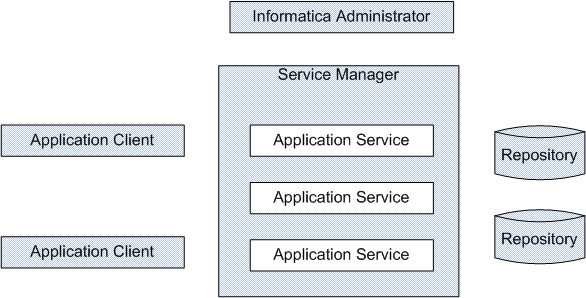Informatica Domain Overview
Informatica has a service-oriented architecture that provides the ability to scale services and to share resources across multiple machines. The Informatica domain is the primary unit for management and administration of services.
You can log in to Informatica Administrator (the Administrator tool) after you install Informatica. You use the Administrator tool to manage the domain and configure the required application services before you can access the remaining application clients.
The following figure shows the components that run inside the Informatica domain:
Informatica contains the following components:
- •Application clients. A group of clients that you use to access underlying Informatica functionality. Application clients make requests to the Service Manager or application services.
- •Application services. A group of services that represent server-based functionality. An Informatica domain can contain a subset of application services . You configure the application services that are required by the application clients that you use.
- •Repositories. A group of relational databases that store metadata about objects and processes required to handle user requests from application clients.
- •Service Manager. A service that is built in to the domain to manage all domain operations. The Service Manager runs the application services and performs domain functions including authentication, authorization, and logging.
The following table lists the application clients, not including the Administrator tool, and the application services and the repositories that the client requires:
Application Client | Application Services | Repositories |
|---|
Data Analyzer | Reporting Service | Data Analyzer repository |
Informatica Reporting & Dashboards | Reporting and Dashboards Service | Jaspersoft repository |
Informatica Analyst | - - Analyst Service
- - Data Integration Service
- - Model Repository Service
- - Search Service
| Model repository |
Informatica Data Director for Data Quality | - - Data Integration Service
- - Informatica Data Director Service
| Human task database |
Informatica Developer | - - Analyst Service
- - Content Management Service
- - Data Integration Service
- - Model Repository Service
| Model repository |
Metadata Manager | - - Metadata Manager Service
- - PowerCenter Integration Service
- - PowerCenter Repository Service
| - - Metadata Manager repository
- - PowerCenter repository
|
PowerCenter Client | - - PowerCenter Integration Service
- - PowerCenter Repository Service
| PowerCenter repository |
Web Services Hub Console | - - PowerCenter Integration Service
- - PowerCenter Repository Service
- - Web Services Hub
| PowerCenter repository |
The following application services are not accessed by an Informatica application client:
- •PowerExchange Listener Service. Manages the PowerExchange Listener for bulk data movement and change data capture. The PowerCenter Integration Service connects to the PowerExchange Listener through the Listener Service.
- •PowerExchange Logger Service. Manages the PowerExchange Logger for Linux, UNIX, and Windows to capture change data and write it to the PowerExchange Logger Log files. Change data can originate from DB2 recovery logs, Oracle redo logs, a Microsoft SQL Server distribution database, or data sources on an i5/OS or z/OS system.
- •SAP BW Service. Listens for RFC requests from SAP BI and requests that the PowerCenter Integration Service run workflows to extract from or load to SAP BI.
Feature Availability
Informatica products use a common set of applications. The product features you can use depend on your product license.
The following table describes the licensing options and the application features available with each option:
Licensing Option | Informatica Developer Features | Informatica Analyst Features |
|---|
Data Explorer | - - Profiling that includes using the enterprise discovery profile and discovering primary key, foreign key, and functional dependency.
- - Curate inferred profile results
- - Scorecarding
| - - Profiling including enterprise discovery
- - Scorecarding
- - Use discovery search to find where data and metadata exist in the profiling repositories
- - Curate inferred profile results
- - Create and run profiling rules
- - Reference table management
|
Data Quality | - - Create and run mappings with all transformations
- - Create and run rules
- - Profiling
- - Scorecarding
- - Export objects to PowerCenter
| - - Profiling
- - Scorecarding
- - Reference table management
- - Create profiling rules
- - Run rules in profiles
- - Bad and duplicate record management
|
Data Services | - - Create logical data object models
- - Create and run mappings with Data Services transformations
- - Create SQL data services
- - Create web services
- - Export objects to PowerCenter
| - - Reference table management
|
Data Services and Profiling Option | - - Create logical data object models
- - Create and run mappings with Data Services transformations
- - Create SQL data services
- - Create web services
- - Export objects to PowerCenter
- - Create and run rules with Data Services transformations
- - Profiling
| - - Reference table management
|

